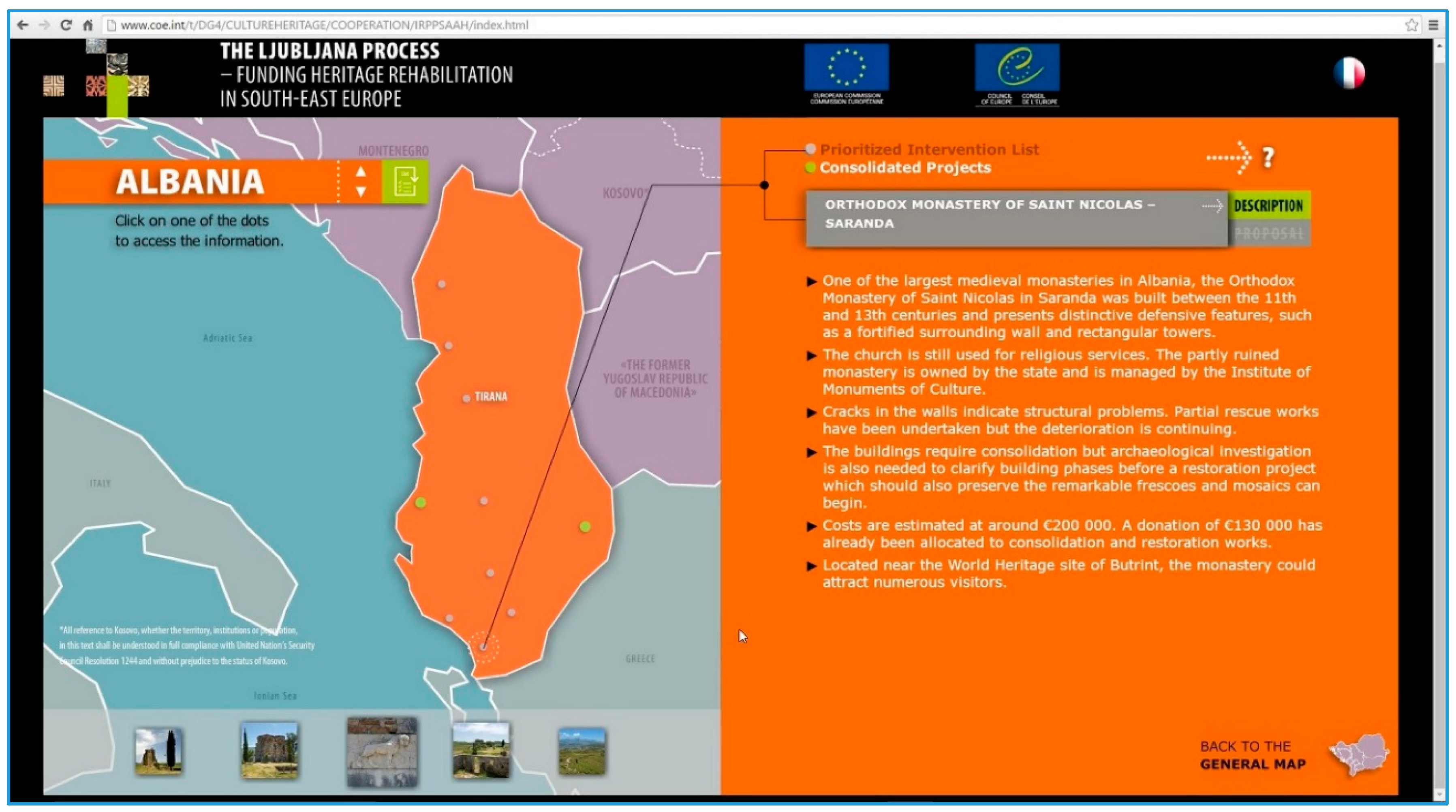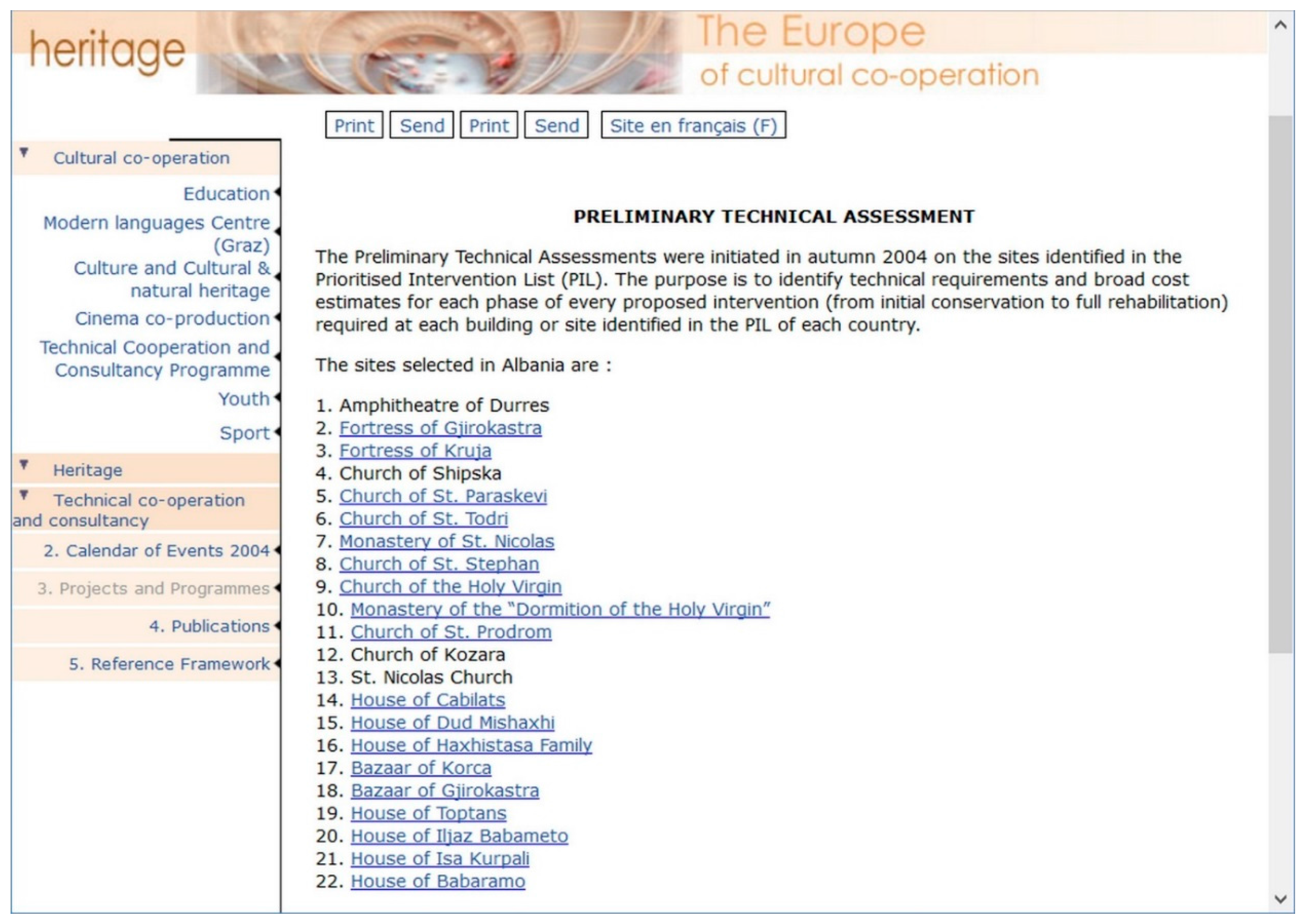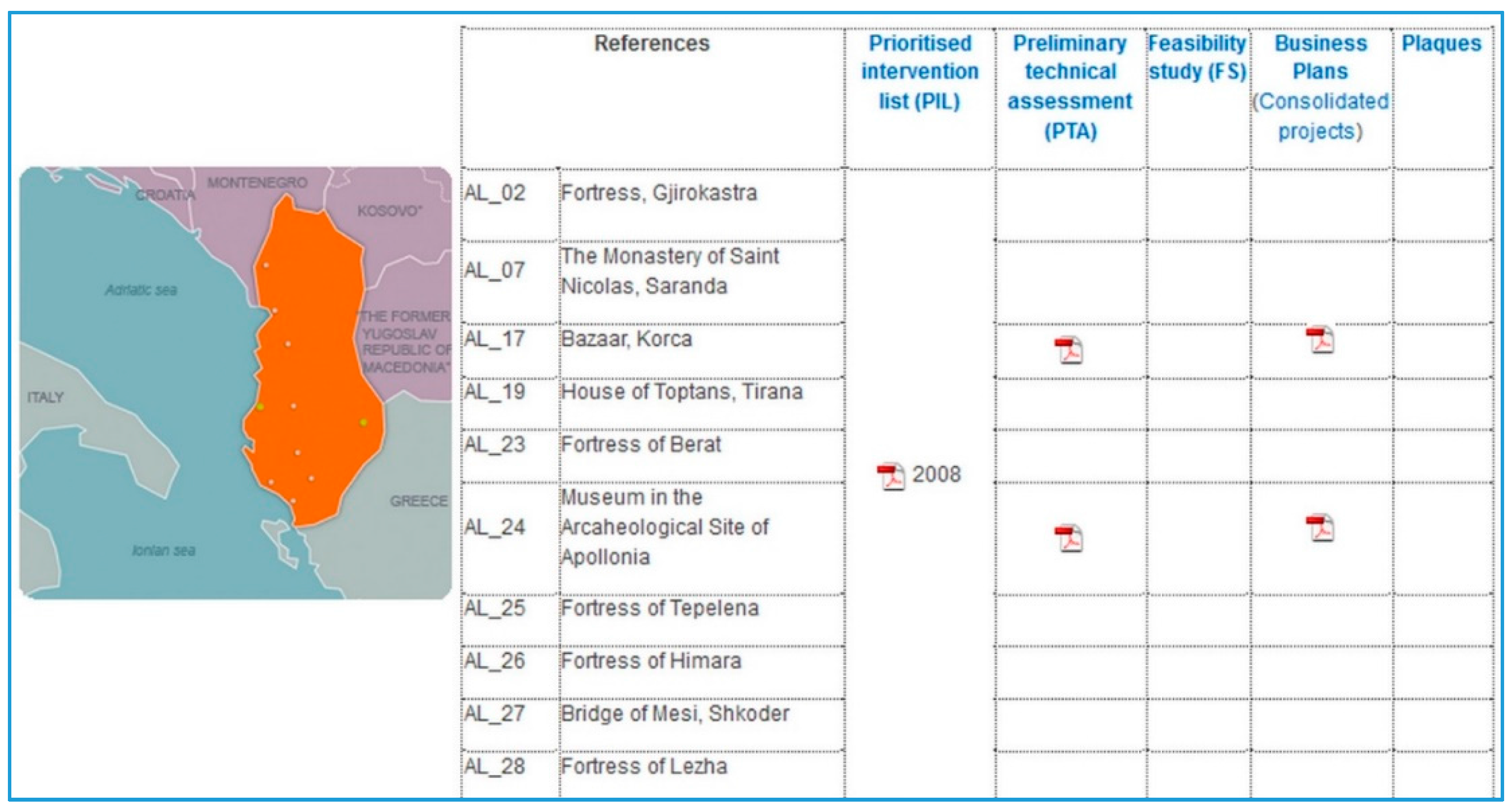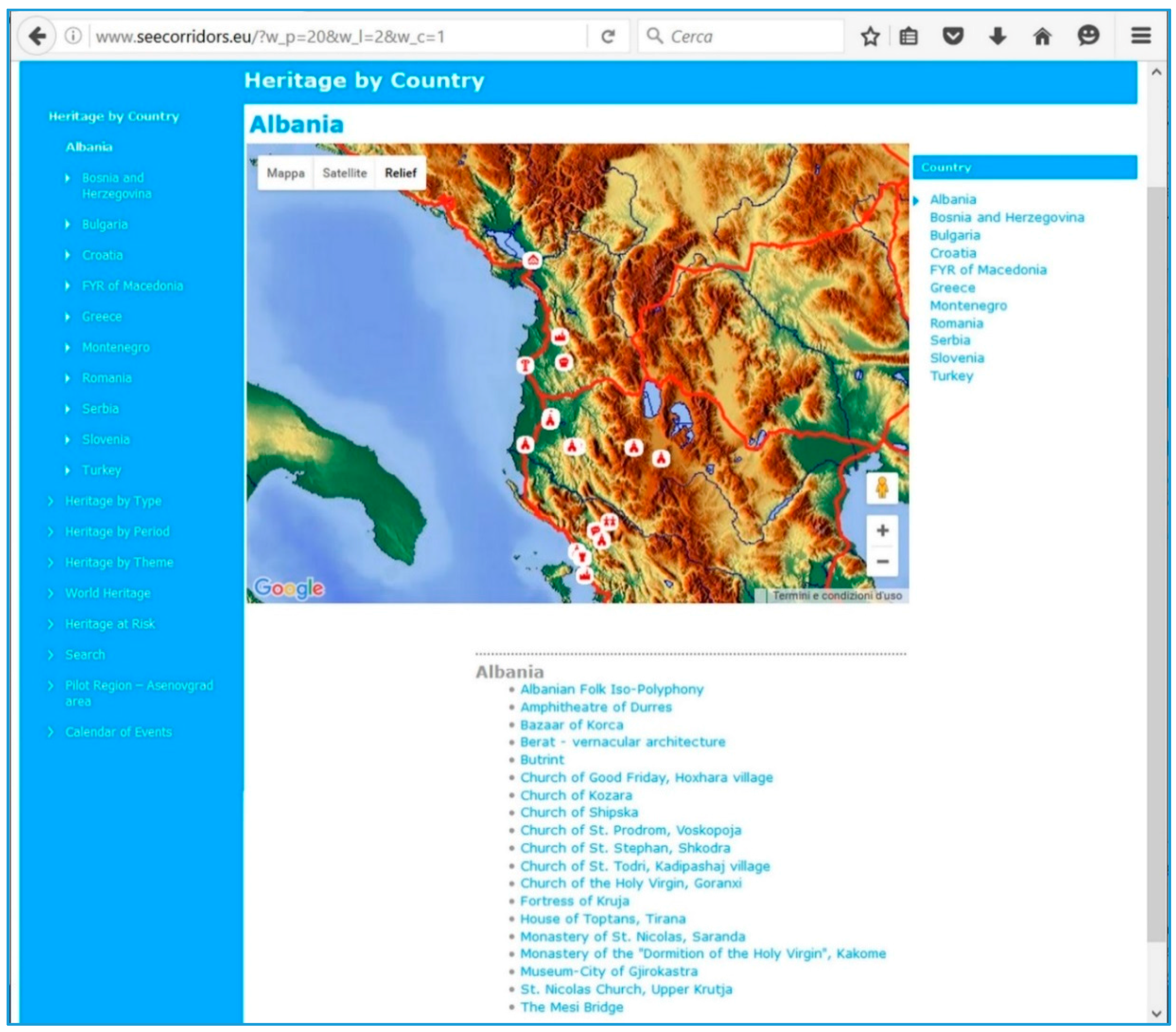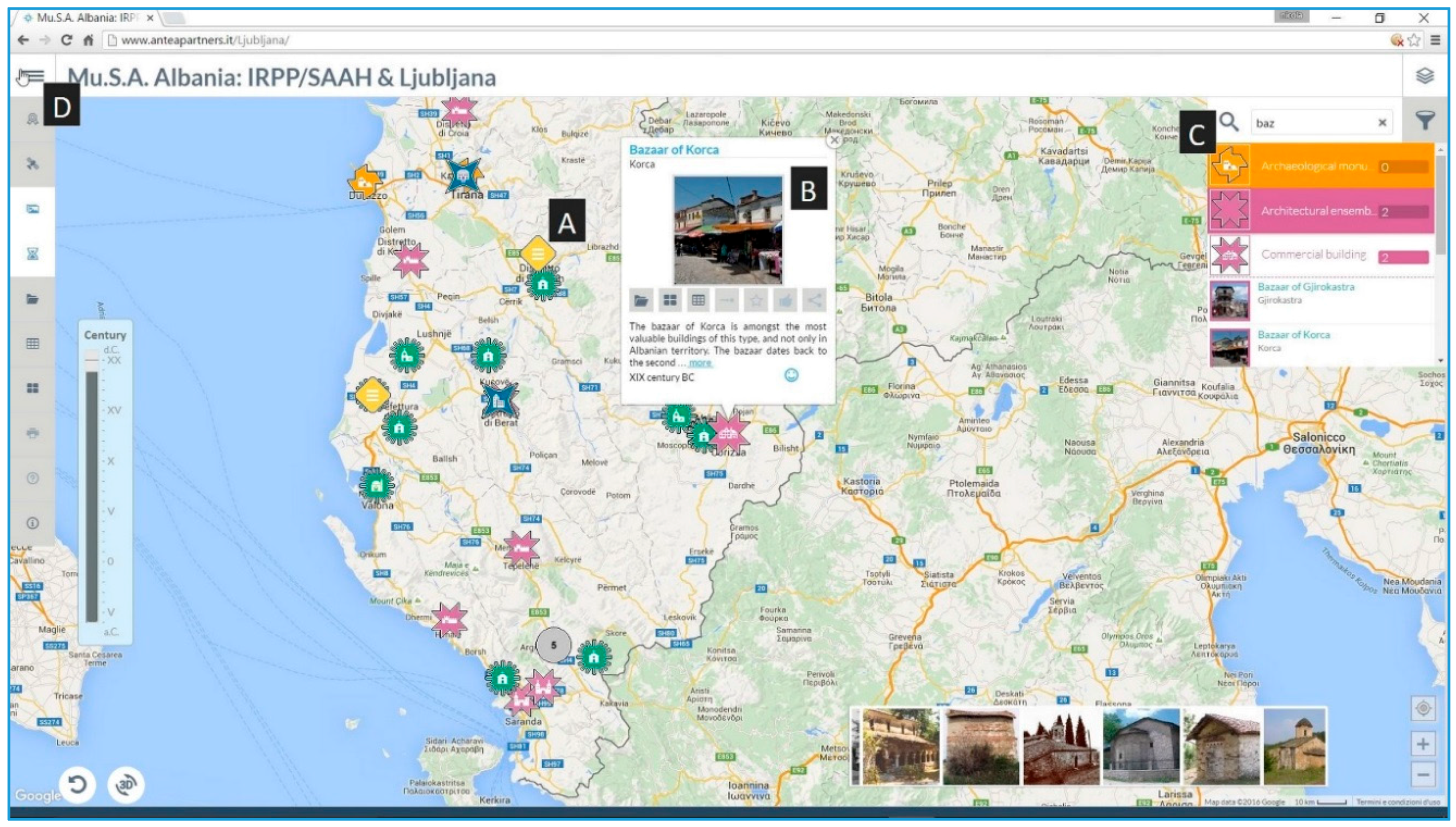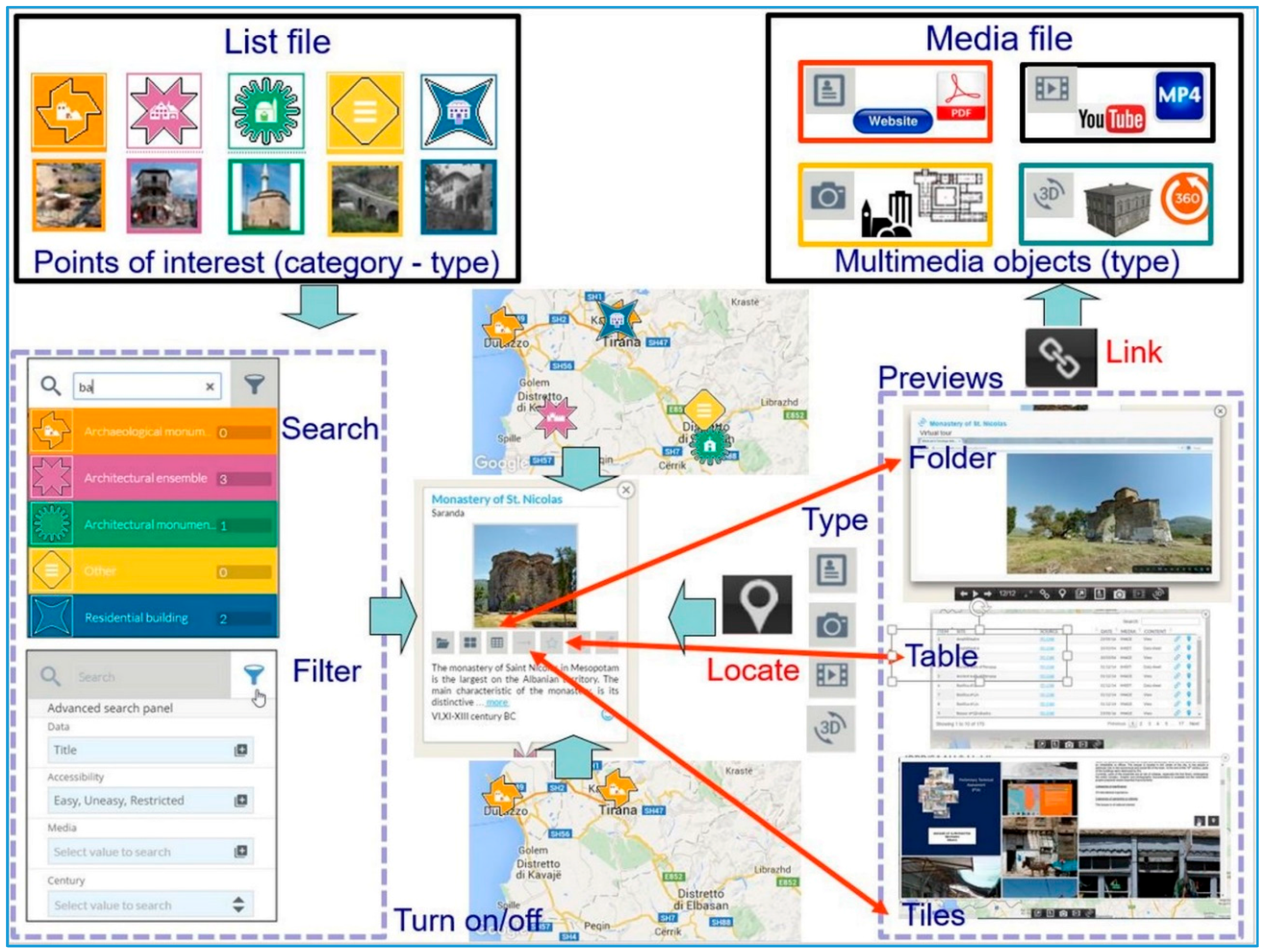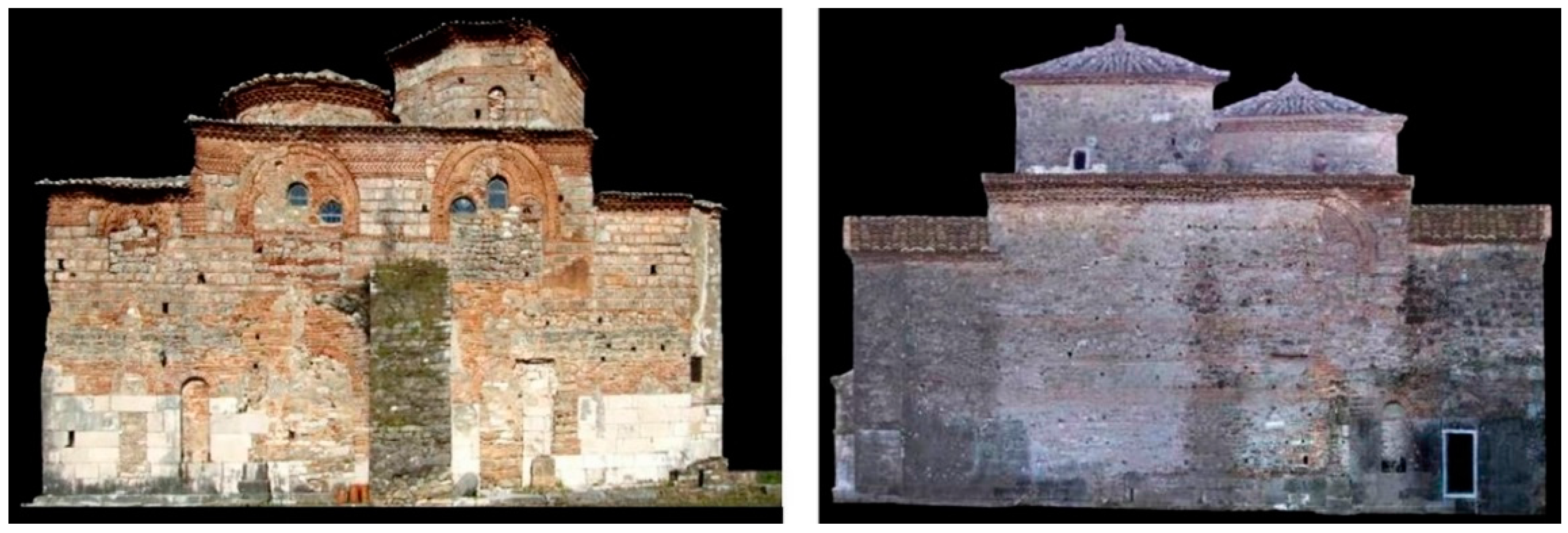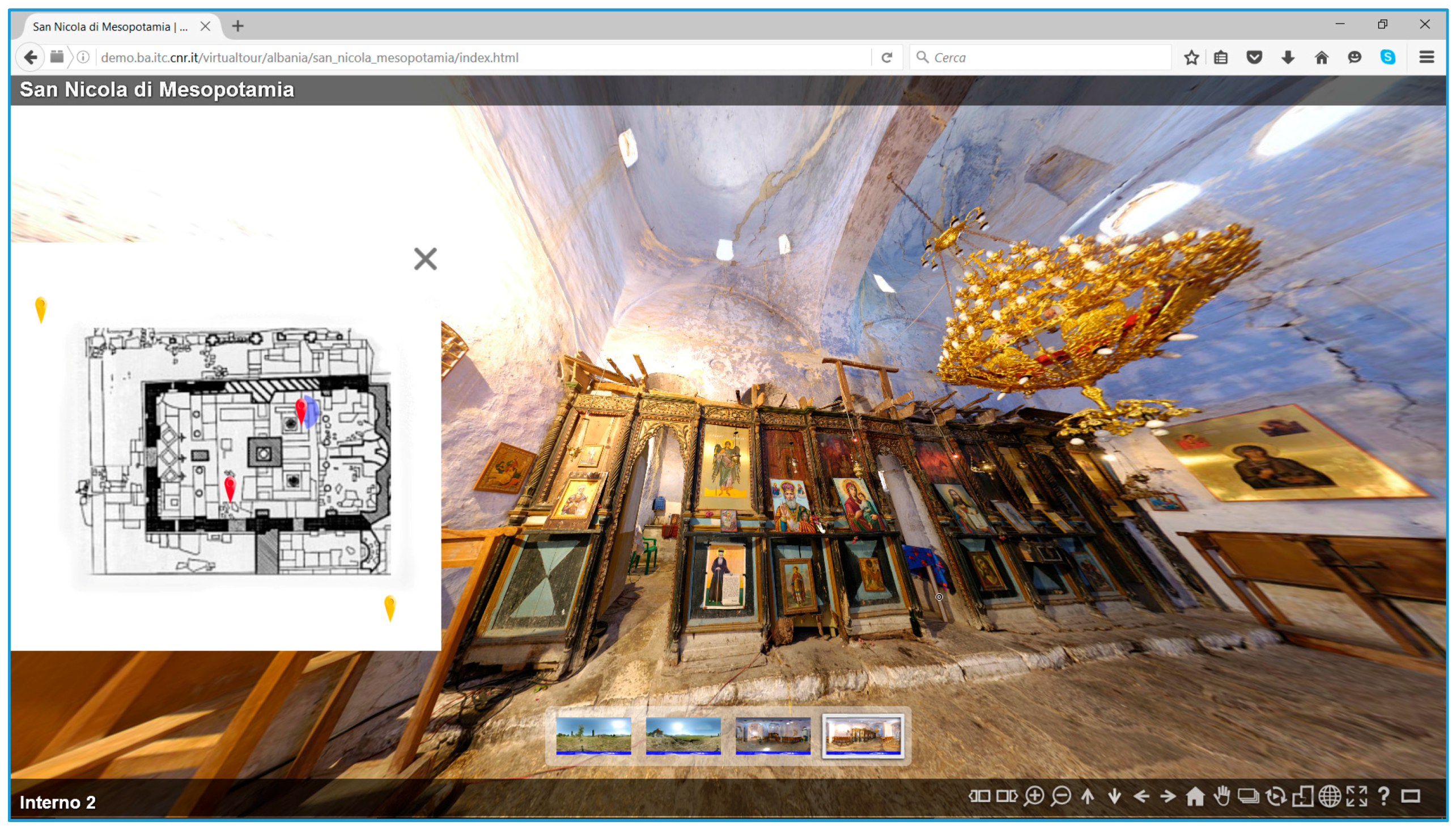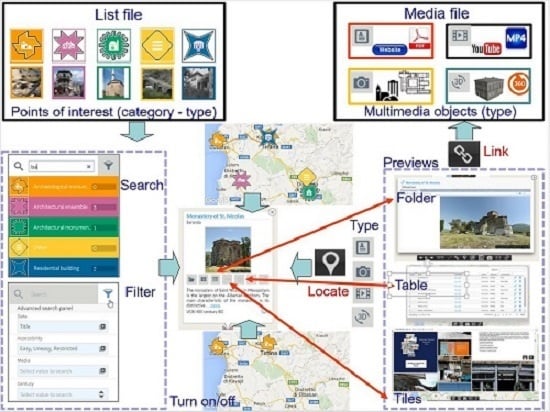1. Introduction
The cultural heritage of South-East Europe (SEE), in its built and natural components, is currently facing demanding new challenges.
International operators are taking fresh interest in SEE coastal regions as tourism destinations, while these are simultaneously affected by intense urbanization pressures, which results in an uneven territorial development. So one challenge awaits related to mitigating such imbalance by improving the cohesion of coastal and inland areas and relieving congested zones.
On the other hand, the abundance of cultural resources and the acknowledgement of common features and problems in the role played by heritage in the development of territorial identities have been directing EU institutions’ attention to the opportunity of developing common processes of heritage-led regeneration.
One important example of this higher level of complexity in policies is represented by the Ljubljana Process, aimed at supporting government alignment with European best practices and the principles of main program documents such as the Granada, Valletta, Florence, and Faro Conventions. It has a three-step strategy: Priority Intervention Lists (PILs), Preliminary Technical Assessment (PTA), and identification of economy and life-quality benefits for communities. The Process requires a substantial shift in SEE countries’ vision as to the significance and role of cultural heritage, from seeing it as a simple economic resource, in relation to tourism exploitation, to viewing it as an engine for the reconciliation, democratic development, and socio-economic growth of communities.
In this sense, approaches to sustainable promotion of cultural heritage in SEE regions need to be matched and integrated into more general and community-centered processes and principles with adequate strategies and tools.
This article presents a possible approach to cultural heritage promotion in Albania through the project “SCHEME—School for Cultural Heritage through Map Exploitation”, successively enlarged with other partners with additional features and presented with another name, to that of the recent announcement of the ADRION Program.
2. The Albanian Heritage: The Need for New Approaches
In the Adriatic-Ionian landscape, Albania represents a rather peculiar case. The nation has a very rich heritage but has suffered considerably from a long period of isolation (1950–1990), during which concerns for the slowdown of economic development and the increase of poverty among the community overshadowed heritage-related matters. More recently, there have been many positive achievements in raising awareness of the role of preservation, restoration, and rehabilitation of cultural resources, but, despite its rich heritage, the country is still lacking in sector-specific strategies. The guide to the cultural policy of the Albanian State [
1] simply affirmed the importance of cultural heritage for the democratic development of the nation and identified several objectives, without specifying any strategy for their realization.
Apart from the draft Sector Strategy on Cultural Heritage, as a component of the draft strategy for culture and arts, cultural heritage is integrated into wider policies and related documents, such as the Sector Strategy on Tourism 2007–2013 and the National Strategy for Development and Integration 2007–2013. This “indirect” attention towards heritage is reflected at the level of financing: cultural heritage receives funding mainly from the Ministry of Finance, sharing that institution’s attention with many other financial concerns.
At the international level, although the national cultural policy is built on European standards—with the goal of interrupting the country’s isolation from the world—many difficulties are to be observed in respect to other Balkan countries: in reconnecting with European models, principles, and milestones; in the alignment to main strategic documents; in terms of their signing or ratification, such as the Valletta, FARO, Granada, and Florence Conventions. In fact, in 2008, only 17 of the 37 UNESCO standard-setting instruments were estimated to have been ratified or accepted [
2].
Along with international programs—such as SEE financing initiatives and calls—other clear signs of a proactive engagement in the formalization of an international dimension of processes are to be seen within Albania as can be read in the position expressed within the ICOMOS International Scientific Committee on Cultural Routes (CIIC) by Valter Shtylla (IMK) [
3].
Since such an international dimension is a necessity, attention must be paid to the definition of strategies. The possible formalization of a common South-East European heritage can contribute to redefining financial resource allocation from within single countries towards assets outside national borders, which holds potential for a more balanced development of regional territories. However, given the economic repercussions of heritage promotion on tourism-related sectors, such ambition risks remaining a mere intention on paper, against the unwillingness of some to renounce domestic investment in favor of other countries.
Thus, it becomes essential that processes of value definition are carried out from the bottom up, led by communities influencing governments rather than expecting them to lead the way. In Albania, this means a reconciliation not only within the Albanian community with its heritage and past [
4] but also a reconciliation among the different SEE countries.
On the other hand, clear assessments are widely to be found in official declarations about the perception of culture as a strategic tool for democratic development and for the affirmation of the Albanian identity within the SEE region and within the whole European image. The nation is also committed to a strong decentralization effort, since Albanian cultural life has long remained concentrated within the capital, where most heritage-related institutions are located, which does not support enabling processes in local contexts.
Still, the awareness of the importance of heritage among communities is not fully acquired. The issue of intentional damage for building expansion purposes is striking: in 2012, the “Instituti i Monumenteve të Kulturës” (IMK, the Albanian Institute for Cultural Monuments, under the jurisdiction of the Ministry of Tourism, Culture, Youth, and Sports) denounced the damage, loss, and transformation of many monuments [
5]. This circumstance suggests that a large part of society still looks at its heritage as an obstacle to development rather than leverage for it, where specific actions are needed at the level of local communities and citizens. Indeed, some signs are already apparent that the potential role—and rights—of residents in protecting cultural heritage is being properly considered, one example being the “Save the treasure “ website (implemented by the Ministry of Culture) where users can report on or indicate damaged sites.
What may critically prevent this new awareness from taking root in the active and proactive sense is the lack of information on resources, related laws, and generally on what can really “enable” residents and visitors to be active “decision makers” rather than passive recipients of cultural offers, plans, initiatives, and messages.
Studies on Albanian heritage have pointed out how national and regional histories and dynamics rise from the bottom up and how, in Albania more than in other countries, marginalized groups of individuals are also able to take part actively in the creation and management of heritage and to play a role in heritage policy [
6]. From this perspective, the role of memory in heritage creation is essential in order to activate the post-crisis “agentive change” cited by Bourdieu and Passeron [
7] and, specifically applicable to Albania, is needed to re-signify cultural heritage [
6].
Therefore, it is important to place residents, instead of only tourists as usual, at the center of promotion processes in order to exploit the power of memories. It is all about—to use the words of Michael L. Galaty—bringing heritage significance again into the “realm of opinion” [
6], by supporting the emerging and conscious expression of memories with the help of new and accessible tools. Differing little from the “reworking-of-the-past” vision of De Jong and Rowland [
8], the aim of the system presented here is to put the painful and hidden memories together with the less traumatic, closer, and fresh—positive—ones that are more immediate among young people.
Many positive changes have occurred in this scenario, although in a fragmented way, and great expectations are placed on the country’s response to the whole Ljubljana Process, focusing on:
heritage promotion as a bridge among peoples and territorial identities;
the associated benefits for local economies and life quality; and
the implementation of the “Integrated Rehabilitation Project Plan/Survey of the Architectural and Archaeological Heritage (IRPP/SAAH)” methodological frame.
Despite this, some points are to be considered. To some extent, the process has produced important effects in Albania, which has suffered more than other countries from shortage of funds, lack of adequate skills, and information fragmentation among staff involved in heritage management (also due to restructuring of institutions). The adoption of the IRPP/SAAH methodology has triggered a positive change in terms of cooperation models among different staff and competences, thus determining the creation and diffusion of a common language among professionals. Indeed, the peculiar composition of primary funding, mostly coming from institutions or ministries for which heritage is not a “core responsibility” [
5], should have laid the basis for cooperation, but the stronger concern for more urgent matters has led to the fragmented situation depicted. The IRPP/SAAH has delivered concrete common objectives to pursue, creating the playground for common work. It has also produced useful material on cultural assets and suggested the need for a revision of cataloguing and documentation practice.
Some other issues of the IRPP/SAAH methodology itself, on the other hand, do not go in the direction of decentralization sought by the country, but in the opposite sense, since the methodology places the process at the high levels of governance (ministries and state institutions). So those important signs of change, in terms of goals and models, are estimated not to reach the general public [
5], which could frustrate the social objectives of the Ljubljana Process. More precisely, heritage promotion processes, even when strongly integrated into this perspective, need to be supported by a new approach that addresses actual problems—fund shortage, data fragmentation, insufficient access to information—through social inclusion and the contribution of communities.
In this sense, educational institutions and school communities can play an important part as cradles of future citizens. Planned joint activities and initiatives involving the “Istituto per le Tecnologie della Costruzione” (ITC, the Construction Technologies Institute of the National Research Council of Italy) and IMK are developed around a new approach to heritage promotion.
In the following paragraphs, a user-centered approach in current project ideas involving ITC and IMK will be described, focusing on school communities and new tools supporting their relationship to cultural resources. On the basis of the important changes introduced by the recent EU policy, it is of the utmost importance to build strategically on these last developments and capitalize on them, making the most of existing technologies in order to start an organically articulated process with social inclusion as the main driving force. The Albanian heritage sector sees Italy as one of the major players in promotion projects, together with UNDP, UNESCO, and other foreign governments like the USA and Germany [
5]. From this perspective, ITC and IMK aim at also capitalizing on experiences and lessons learned in recent and successful joint projects, according to the need already expressed to raise awareness on a national and international level through common and concrete projects [
3].
3. Capitalizing Experiences and Existing Technologies
Heritage conservation has demonstrated its significant role in sustaining local communities, not only by reinforcing local identity, traditions, and practices, but also by bringing economic benefits through well-managed tourism. The necessity of raising awareness about this concept motivated the development (from 2003 to 2010) of the IRPP/SAAH. It was a joint program in South-Eastern European countries (Albania, Bosnia and Herzegovina, Bulgaria, Croatia, Kosovo, the Former Yugoslav Republic of Macedonia, Montenegro, Romania, and Serbia).
The first output was the Prioritized Intervention List (PIL) based on a specific Heritage Assessment Report for each country. It comprises endangered buildings and sites with a huge potential for rehabilitation and contribution to environmental, social, and economic revitalization. The PIL is a collection of short reports including information such as country, name and address of building(s) or site(s), inventory reference number(s), building type(s), main date(s), current use(s), significance, categories of significance, categories of ownership or interest, documentation, bibliography, condition, risk, condition risk, technical assessments and costing, ownership, occupation, management and summary.
One hundred and sixty sites and monuments were identified in 2004 for protection, conservation, restoration, and valorization across the whole region: 22 in Albania; 20 in Bosnia and Herzegovina; 15 in Bulgaria; 18 in Croatia; 25 in Kosovo; 17 in the Former Yugoslav Republic of Macedonia; 10 in Montenegro; 16 in Romania and 17 in Serbia. The PIL for Albania comprises 22 monuments and sites [
9] as reported in
Table 1, Section A. For selected assets included in the PIL, a rehabilitation project was produced [
10], which is articulated in a Preliminary Technical Assessment (PTA), a Feasibility study (FS), and Business Plan (BP). The developed PTAs, available in 2006 [
11] (p. 15) and downloadable at the Council of Europe website (
Figure 1), are not yet available. Nowadays, the PIL 2004 and the PTAs documents are available at the Construction Technologies Institute; moreover, the Albanian documents are accessible through the map illustrated in the
Section 4.1.
The SEE countries have approved two PILs, in 2004 and in 2008, listing 189 monuments and sites [
12] (p. 5). Unfortunately, also the PIL 2008 documents are not yet available, despite the link provided in the official website; for Albania (
Figure 2), only 10 sites are listed: the first four are between the 22 items included in the PIL 2004; the other six are new items.
In order to demonstrate the tangible results of the IRPP/SAAH methodology, the Council of Europe and the European Commission, placed a plaque on (or near) the monuments and sites listed as intervention priorities by national authorities. By installing the plaque, the relevant authorities accepted the institutionalization of the continuing program of rehabilitation, demonstrating their long-term commitment and achievement.
On the basis of the PTAs and FSs published, 107 plaques where awarded in 2007 [
15]. The project was further promoted through the awarding of more plaques in 2009, probably referred to as PIL 2008 (10 sites in Albania as reported in [
16], strangely without being named). Almost all sites listed in the IRPP/SAAH PIL 2004 have been included in the “Cultural Corridors of South East Europe” website [
17] through an interactive map (
Figure 3).
The interactive map provides search functionality and allows users to filter data by:
country (19 sites in Albania)
type (Ancient Site, Christian religious center, Islamic religious center, Jewish religious center, Fortress, Historic Town, Vernacular Architecture, Cultural Landscape, Intangible Heritage and Industrial Site)
period (20th Century, Modern Times, Middle Ages, Antiquity and Prehistory); and
theme (Antiquity, Christian Monasteries, Islamic Culture, Fortresses; Vernacular Architecture and Intangible Heritage).
No callout or label is provided for each site localized on the map through white markers using red icons (with different shape according to type); an “Info” page provides information (Corridor, Country, Type, Epoch, Theme, World Heritage, Description and Documents), image gallery and links. For Albania, 19 sites are listed: a selection of sites included in the PIL 2004, merged with Butrint and Girokastra as UNESCO sites, and an intangible heritage item (Albanian Folk Iso-Polyphony).
The documents provided for sites included in the PIL 2004 have been extracted from [
9]. Those referring to the UNESCO list are only “samples” (they have content missing).
After this successful first phase, in 2011, a new operational framework was launched, the “Ljubljana Process II: Rehabilitating our Common Heritage” with the agreement of the Ministers of Culture of South-East Europe.
The project was implemented by the “Regional Cooperation Council (RCC) Task Force on Culture and Society” with the financial support of the Instrument for Pre-Accession [
18], giving accurate instructions for the development of the technical documents.
Unfortunately, the reports included in the brochures available in the “Promotional Material” official webpage [
19] as well as in the PIL 2012 webpages for each country, include only name, location, construction date, summary, description, categories of significance, rehabilitation potential, ownership, management, and current use.
The brochure for Albania [
20] comprises the reports for 10 sites —as in [
21]—reported in
Table 1, Section B. The House of Haxhistasa (
Table 1, Section B, site B3) is also included in the previous PIL 2004 (
Table 1, Section A, site A16).
On the other hand, another report is available on the web [
22], more exhaustive and calibrated to the above-mentioned exhaustive instructions given in [
18] (pp. 31–62).
This second phase of the process, concluded in May 2014, set the ground for the sustainability of rehabilitation processes by ensuring that they will be managed by the countries themselves.
The final information is now available directly on the Council of Europe website. The sites selected in Albania, gathered from the interactive flash application [
23] and reported in
Table 1, section C, are different from the Ljubljana II PIL 2012 and partially included in the IRPP/SAAH PIL 2004 (site C3 = site A14; site C6 = site A17; site C8 = site A2; site C10 = site A7).
Such methodology has positively changed attitudes to heritage, not only becoming a model for its documentation, but also increasing its visibility, determining fund allocation for its rehabilitation, and enabling national authorities to acknowledge their responsibilities for sites and monuments.
However, it should be noted that, at least for Albania, “general public awareness of the Ljubljana Process is low and virtually invisible even on government websites and in state publications… A better environment is needed for sharing information in order to raise awareness, participation and future funds” [
24]. Moreover, as usually happens in most countries, in Albania, the national list of protected sites has also been defined with a top-down approach, through experts’ proposals, often without engaging local communities. This recurring deficiency, especially damaging in those areas dealing with the fears of a traumatic past [
4], is now replaced by initiatives in which the local affected community plays a key role as—for example—the movement to understand post-Communist heritage in Albania, which saved the pyramid-shaped building in downtown Tirana (formerly the Hoxha’s personal museum) from destruction by petitions against the government’s decision to demolish it.
4. The SCHEME Project
The SCHEME project considers the need to improve the visibility of all activities developed in the IRPP/SAAH and Ljubljana processes in Albania, removing the above-mentioned uncertainties about sites included in the PILs and their documentation. Moreover, our approach will offer the opportunity for utilizing GIS as a tool for research and awareness-raising purposes [
25], giving local communities proper interactive maps, according to those available on the above-mentioned “Cultural Corridors of South East Europe” website. Finally, correctly geo-localized information (we use a GPS camera) has been adopted to avoid mistakes sometimes existing in tourist services as—for example—the wrong location of the Monastery of Saint Nicolas [
26].
The project is being developed in collaboration with IMK due to its responsibility for IRPP/SAAH and Ljubljana processes in Albania and to its longstanding collaboration with ITC:
“A3C—Albania: Conoscere, Comunicare, Condividere” (Albania: Know, Communicate, Share) cooperation project (INTERREG III-A FESR/CARDS Italy—Albania 2004/2006 Proximity Program) mapping 50 sites [
27] throughout Albania;
“S.O.S.—Shqipëria Open Source” cooperation project (“L.R. Puglia n. 20”), mapping 46 sites in the districts of Saranda, Tirana, and Vlora [
28].
The SCHEME project has three phases: map and crowdfunding platforms development; knowledge-building and contest; technical assessment and crowdfunding.
4.1. Map and Crowdfunding Platforms Development
The first phase is aimed at improving a tool ITC is already developing, based on the “Smart Map+” procedure of the “Mu.S.A.—Must See Advisor” project, which includes:
planning and execution of a survey of points of interest (POIs) with acquisition of photos;
geo-localization of POIs using maps or metadata from images taken by GPS camera; and
data input and map generation through a software program (authoring system–see below).
The capacity-building activity done at a secondary school in the “Mu.S.A.” project indeed highlighted the opportunity to improve the friendliness of the authoring system and to develop more functionalities for the interactive map and its callout. These improvements are in development with IMK, using IRPP/SAAH and Ljubljana II data for testing activity—a beta version of the interactive map is still available (
Figure 4).
ITC is also developing an online crowdfunding platform for the NRC—National Research Council of Italy in the “PROMPt—Project Opportunities Matching Platform” project (the 2nd winning project within the 2015 edition of the NRC “Innovation Award”, proposed and coordinated by Antonella Lerario), dedicated to financing research projects [
30]. In our project, the software engine of the platform—conceived with a modular system architecture—will be re-used, and a specific interface will be developed, in order to better meet the peculiar contents and conveyed message of the project.
4.2. Knowledge Building and Contest
The second phase consists in the selection of less-well-known resources located around the pilot area, using the following rules:
the inclusion in the PIL produced in IRPP/SAAH or in Ljubljana II;
the inclusion in a UNESCO or UNESCO candidate plan;
the presence of natural assets in the surrounding areas, especially related to the water, due to its multiple facets (sacredness, health spa, and so on).
In any case, the IRPP/SAAH methodology will be used, extended to include the geographical location of sites at the street level (useful for mapping purposes, allowing users to reach the site) and its physical accessibility (useful to select sites according to user needs).
The data will be uploaded in the map platform, allowing a contest development among students—the citizens of tomorrow—aimed at acquiring memories (texts, images, videos) in order to improve the attractiveness of the less-well-known resources. ITC and IMK will judge the memories and select the “less-well-known” resource winner, which will be a candidate for the crowdfunding activities.
4.3. Technical Assesment and Crowdfunding
In this third phase, the goal is to supply the winning asset with a modular demonstration project, suitable for collecting donations through the crowdfunding platform developed and tested in the first phase.
At this stage, ITC will develop advanced surveys for the above mentioned winner to give a deepened representation of buildings and surroundings through a 3D model and 2D plans, using new tools and equipment to produce improved results with respect to “orthoplans” (
Figure 7) and a virtual tour (
Figure 8) produced in previous researches with IMK.
The project then considers the development of the PTA for the winning asset, using the improved IRPP/SAAH methodology to realize a modular demonstration project.
The goal is to realize specific and technical documentation in order to ensure projects are of an appropriate maturity to receive funding. The modular demonstration project will be uploaded in the crowdfunding platform already in development [
30].
As a final step, the crowdfunding platform will be activated.
5. The Pilot Area
The Lake Ohrid Region is a place of great natural beauty and resources. Currently, the Municipality of Pogradec has an active role in the process for including the Albanian part of Lake Ohrid in the World Heritage List by extending the existing World Heritage site, Natural and Cultural Heritage of the Ohrid Region, Former Jugoslav Republic of Macedonia. This process is being led by the Ministry of Environment of Albania and UNESCO, financed by EU, and main actors include IUCN, ICOMOS, the Ministry of Culture of Albania and the Municipality of Pogradec.
This project will help the Municipality of Pogradec in its work to develop and increase sustainable tourism and promote natural and cultural values of the region. This project will also assist the Municipality of Pogradec in the preparation of complete data on the natural and cultural resources of the Lake Ohrid area that will help in the process of World Heritage nomination.
Lake Ohrid is considered to be one of world’s oldest lakes, with one of the largest reserves of biodiversity and some of the oldest human settlements in Europe.
The convergence of distinctive natural values with the quality and diversity of its cultural, material, and spiritual heritage makes this region truly unique.
Basilica of Lin: The remains of the structures of the basilica (included in the PIL 2012) are located on the top of a peninsula formed by a hilly outcrop close to the lakeshore, which is connected to the mainland through a stretch of lowland, and is today converted into arable land. Thanks to this location, the site enjoys an open and spectacular view over the lake. The site is fenced (one staff member from the Regional Directorate of Korça for National Culture is responsible for opening the fence to visit the site). The remarkable mosaic is protected by a polyethylene sheet and a layer of sand to prevent rainwater from damaging it. Although this layer probably represents the best way, given the available means, to protect the mosaic, if the relevant institutions intend to open it to visitors, a different solution should be envisioned to prevent exposure of the mosaics to the weather and, at the same time, facilitate its appreciation.
The village of Lin: At the foot of the promontory on its northern side lies the village of Lin, inhabited by farmers and fishermen. It retains a number of traditional, simple rural houses. Its streets are partly paved with modern colored concrete bricks and are partly still unpaved. For its location and conformation, the whole of the outcrop with the village retains aesthetic landscape qualities that deserve to be safeguarded from improper urban development, which is already taking place with the construction of a number of new, out-of-scale buildings on the western edges of the village.
Pile-dwelling archaeological site (settlements): In the south of Lin, the remains of a pile-dwelling settlement were documented. Meanwhile, ongoing studies and underwater archaeological research undertaken by the Albanian Institute of Archaeology are gathering very interesting information on these settlements.
From a natural point of view, also in the framework of World Heritage extension, work is needed to increase knowledge of natural values of the area and their status, biodiversity mapping, valorization of goods and services the lake provides to a broader community, the role played within this geo-cultural basin along the centuries by today’s Albanian side of Lake Ohrid, and eventually its specific cultural significance.
Some of the most important monuments in the region of Lake Ohrid (inland) are the monumental tombs of Lower Selca: archaeological excavations have brought to light an interesting necropolis consisting of five graves with monumental entrances carved in stone dating back to the IV–II centuries BC. Their monumental character, but also their relatively long periods of construction, connects the Tombs of Lower Selca to a royal Illyrian dynasty of the early IV century BC, apparently, the kingdom of Bardhyli. The monumental tombs of lower Selca have been part of Albania’s Tentative List since 1996.
6. Discussion
The idea behind this project, e.g., heritage promotion through social inclusion, has been elaborated and presented—together with other partners—to the recent announcement of the ADRION Program call.
The main goal of the SCHEME project is to promote the connection of major heritage attractors—mainly located in coastal sites—to lesser-known cultural resources of inland areas, through the valorization of knowledge and memories that lie among communities, expression of old and new significance for the territory, and the financial support of one specific rehabilitation project.
Such connection can effectively facilitate a more harmonized growth of the territory, by evening out the existing imbalance between a neglected inland and resources of main towns and coasts that exert a stronger appeal to urbanization dynamics and to visitor flows. Positive results in terms of reduced impact and ecological footprint will be achieved by lightening the environmental burden on congested and overstressed coastal zones, while at the same time fostering the development of internal areas by bringing to light new appealing sites for everyday life or travel experiences.
Far beyond environmental repercussions, the SCHEME project’s contribution towards a sustainable heritage system unfolds also in social and economic terms, since long-neglected areas will be prompted to become desirable places to live or stay, through the revitalization of their significance for resident communities and through the promotion of their artistic, cultural, or natural value among potential visitors.
On the one hand, one expected change is an increased capacity of stakeholders to sustainably valorize hidden resources allowing diversification of tourism products. Positive outcomes can derive from the development of general tourism activities, the increased continuity of tourism income all the year and the integration of internal areas—up to now marginalized—into the overall productive system of the country. On the other hand, a deeper knowledge and more awareness of resources on the part of residents will contribute to better direct decisions, projects, and actions by administrators towards more significant assets, relying on community consensus.
The project is specifically in line with the Strategy on Culture, in that SCHEME supports the desired process of decentralization of culture allowing citizen and community participation in promotion processes through tools and action. It can effectively contribute to the Strategy’s goal of re-asserting the country’s cultural identity by reconnecting isolated resources across the region to main assets to give visibility to the entire cultural system of Albania. In a context where partnered solutions for participation and consultation by residents are strictly needed but also possible, the project can complement the result of IRPP/SAAH and the Ljubljana Process, since the resulting creation of common language and methodologies—remaining within Albania’s heritage staff—can be externalized among a still-passive general public.
The technological frame of our proposal is also specifically conceived to support bottom-up promotion processes. The authoring system developed by ITC delivers a webGIS with multiple features and functions to support users in searching for cultural heritage information close to their needs, specifically supporting tourism on site, both in the planning stage and during the visit, and also virtual tourism from the part of specific user groups. Future work will extend the use of webGIS as a tool to assist with the process of data-entry adopting a “participatory GIS” approach, an effective method for people to identify and communicate resources and values they consider relevant [
34], stimulating innovation and social change.
The approach is built around the central role played by people—citizens in general, students, and tourists—in increasing heritage visibility through active participation in collecting knowledge and value expression (e.g., the formalization of memories, influencing subsequent process stages). In respect to traditional promotion practices, in which resource consumers represent passive recipients of ready-made offers and messages, this represents a reversion of promotion process flows, contributing to governance innovation.


